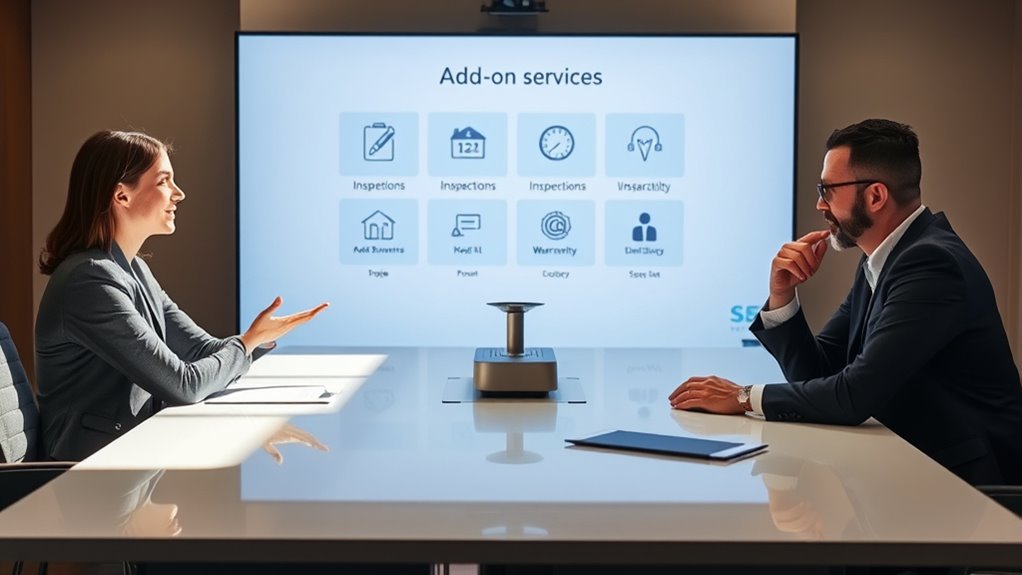When explaining add-on services, focus on understanding your client’s needs first. Listen carefully, ask questions, and identify genuine benefits that improve their experience. Be honest about costs with transparent pricing, and introduce additional options naturally after core needs are addressed. This approach builds trust and shows you genuinely care about their success. If you keep this mindset, you’ll discover more ways to connect authentically and close deals with integrity.
Key Takeaways
- Listen actively to uncover genuine client needs before suggesting relevant add-on services.
- Communicate the value of add-ons honestly, emphasizing how they address specific client problems.
- Introduce additional services naturally after establishing core requirements, maintaining a seamless conversation flow.
- Use transparent, straightforward pricing to build trust and help clients make informed decisions comfortably.
- Personalize recommendations through segmentation to ensure solutions are tailored and demonstrate authentic care.

Have you ever wondered how some sales teams close deals faster and more efficiently? The secret often lies in their approach to consultative selling, especially when it comes to explaining add-on services with integrity. Instead of pushing unnecessary products, they focus on understanding the client’s needs and aligning recommendations with genuine value. This approach builds trust, enhances client engagement, and makes the entire sales process smoother. Central to this strategy are effective pricing strategies that show transparent, fair value, making it easier for clients to see the benefits of additional services without feeling pressured.
Effective consultative selling combines transparent pricing with genuine client understanding for faster, trust-based deal closures.
When you adopt a consultative mindset, you avoid the common trap of overloading clients with options or rushing into upselling. Instead, you prioritize listening and asking questions to uncover what truly matters to them. This not only strengthens client engagement but also makes your suggestions more relevant. For instance, if a client is interested in a basic package, you might identify additional features that genuinely improve their experience, clearly explaining how these add-ons solve specific problems or meet unspoken needs. Your ability to communicate the value of these services honestly and with integrity encourages clients to see them as helpful solutions rather than just sales opportunities.
Pricing strategies play a critical role here. When you present add-on services with clear, straightforward pricing, clients feel more comfortable making decisions. Avoid hidden fees or complicated discounts, as these can erode trust. Instead, offer transparent packages that outline everything upfront, making it easier for clients to compare options and see the tangible benefits. This transparency fosters confidence and positions you as a trusted adviser rather than a pushy salesperson. It also helps clients understand that your recommendations aren’t just about increasing revenue—they’re about providing solutions that genuinely improve their experience.
Another key aspect is timing. When you integrate the discussion of add-on services naturally into the conversation—after establishing the client’s core needs—you create a seamless flow that feels genuine rather than salesy. This approach allows clients to think about supplementary options without feeling pressured, which increases the likelihood of a positive decision. By focusing on client engagement, you demonstrate that your priority is their success, not just closing a deal. This mindset encourages long-term relationships, repeat business, and referrals.
In essence, mastering the art of explaining add-on services with integrity involves blending effective pricing strategies with authentic client engagement. When you do this well, you create a sales environment where clients feel valued, understood, and confident in their choices—all of which lead to faster, more effective deal closures. Incorporating advanced segmentation techniques can further personalize your offers, ensuring that each client receives solutions tailored precisely to their needs.
Frequently Asked Questions
How Do Add-On Services Impact Overall Project Costs?
Add-on services can influence your project’s overall costs by affecting your budget impact and shaping your value perception. When you choose these extras, they may increase expenses, but if they align with your needs, they can enhance value. Being mindful of the costs helps you assess whether the benefits outweigh the budget impact, ensuring you make informed decisions that support your project’s success without compromising your financial limits.
What Are Common Client Concerns About Add-On Services?
Ever wonder if those extra services are really worth it? Clients often express skepticism about add-ons, questioning their true value and how they benefit their project. You might hear concerns about hidden costs or whether these services are necessary. To address this, clearly explain how each add-on enhances the project’s outcome, demonstrating value and transparency. Building trust and showing that you prioritize their needs helps turn skepticism into confidence.
How Can I Identify the Right Add-Ons for My Client?
To identify the right add-ons for your client, start by understanding their customer needs and goals. Listen carefully during consultations to uncover pain points and preferences. Focus on service customization by suggesting add-ons that genuinely enhance their experience or solve specific problems. Keep your recommendations relevant, personalized, and transparent, ensuring your client perceives value and trusts your advice, which ultimately helps close the sale confidently.
What Training Is Needed to Effectively Consult on Add-Ons?
To effectively consult on add-ons, you need training in consultative skills and product knowledge. Focus on active listening, asking the right questions, and understanding your client’s needs. Deepen your product knowledge so you can clearly explain benefits and address concerns confidently. Practice role-playing scenarios to refine your approach. This combination helps you recommend add-ons with integrity, ensuring your clients see genuine value and trust your guidance.
How Do I Handle Objections to Recommended Add-On Services?
When handling objections to recommended add-on services, you should focus on upfront communication and client education. Clearly explain how the add-ons benefit them and address any concerns openly. Listen actively to understand their hesitations, then provide honest, tailored information that highlights value. This approach builds trust, making it easier for clients to see the benefits and feel confident in their decision to proceed with the additional services.
Conclusion
Think of your sales process as a bridge builder guiding clients across a river. By consulting with honesty and clarity, you help them see the safe path forward, making add-on services feel like natural stepping stones rather than obstacles. When you prioritize integrity, you become the sturdy bridge they trust to cross confidently. Ultimately, your genuine approach turns hesitant visitors into loyal travelers, confidently crossing into the destination of satisfaction and mutual success.










